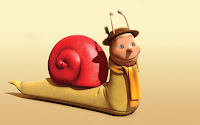I.
When it comes to how we view and remember our poets, I'm all for a certain irreverence. But I don't like caricatures that mock without affection; particularly if they also seem to display a poor reading of the author's work.
In other words, whilst a cruel misportrayal of a writer is objectionable, a crass misinterpretation of their text is unforgivable.
In other words, whilst a cruel misportrayal of a writer is objectionable, a crass misinterpretation of their text is unforgivable.
And so we come to the case of Philip Larkin and his representation as a giant toad during Larkin 25 ...
II.
2010 was the 25th anniversary of Larkin's death and an arts festival in Kingston-upon-Hull culminated on 2 December with the unveiling of a life-size bronze statue of the poet by Martin Jennings. The unveiling was accompanied by Nathaniel Seaman's Fanfare for Larkin, which had been specially composed to mark the occasion.
Although born in Coventry, Larkin had lived and worked (at the Brynmor Jones Library) in Hull from 1955 until his death thirty years later and the city had even named a bus in his honour, so fair enough that the good people thereof should regard him as one of their own and choose to celebrate his life.
However, I'm not sure the centrepiece of the festival is something they can look back on with pride: a work consisting of 40 fibre-glass toad sculptures, each painted with a unique design by a local artist and inspired - or so it's claimed - by Larkin's poetry. Central amongst the designs was The Larkin Toad, by Frances Kelly.
Even at the time, voices of concern were raised. It was said that were it possible for Larkin to have posthumous knowledge of himself reincarnated in bufonid form with dry, leathery skin and short, fat little legs, this would send him spinning in his grave. And Rachel Cooke wrote of the toad stunt that it was:
Although born in Coventry, Larkin had lived and worked (at the Brynmor Jones Library) in Hull from 1955 until his death thirty years later and the city had even named a bus in his honour, so fair enough that the good people thereof should regard him as one of their own and choose to celebrate his life.
However, I'm not sure the centrepiece of the festival is something they can look back on with pride: a work consisting of 40 fibre-glass toad sculptures, each painted with a unique design by a local artist and inspired - or so it's claimed - by Larkin's poetry. Central amongst the designs was The Larkin Toad, by Frances Kelly.
Even at the time, voices of concern were raised. It was said that were it possible for Larkin to have posthumous knowledge of himself reincarnated in bufonid form with dry, leathery skin and short, fat little legs, this would send him spinning in his grave. And Rachel Cooke wrote of the toad stunt that it was:
"so loopily against the spirit of the two poems that are their inspiration - 'Toads' and 'Toads Revisited', in which the squatting toad, impossible to shake off, is both a symbol of work and of the narrator's timid and confining personality - I find myself wondering whether their creators have actually read either one."
And that's the fatal criticism in my view; not that it mocks the man - in whom, by his own admission, something sufficiently toad-like squatted inside - but that it misunderstands (and sells short) his writing.
Notes
Rachel Cooke, 'In search of the real Philip Larkin', The Observer, (27 June 2010): click here to read online.
'Toads' (1954) and 'Toads Revisited' (1962), by Philip Larkin, can be found in Collected Poems, ed. Anthony Thwaite, (Faber and Faber, 2003).
For a sister post to this one - on why I love Larkin - click here.
Rachel Cooke, 'In search of the real Philip Larkin', The Observer, (27 June 2010): click here to read online.
'Toads' (1954) and 'Toads Revisited' (1962), by Philip Larkin, can be found in Collected Poems, ed. Anthony Thwaite, (Faber and Faber, 2003).
For a sister post to this one - on why I love Larkin - click here.











